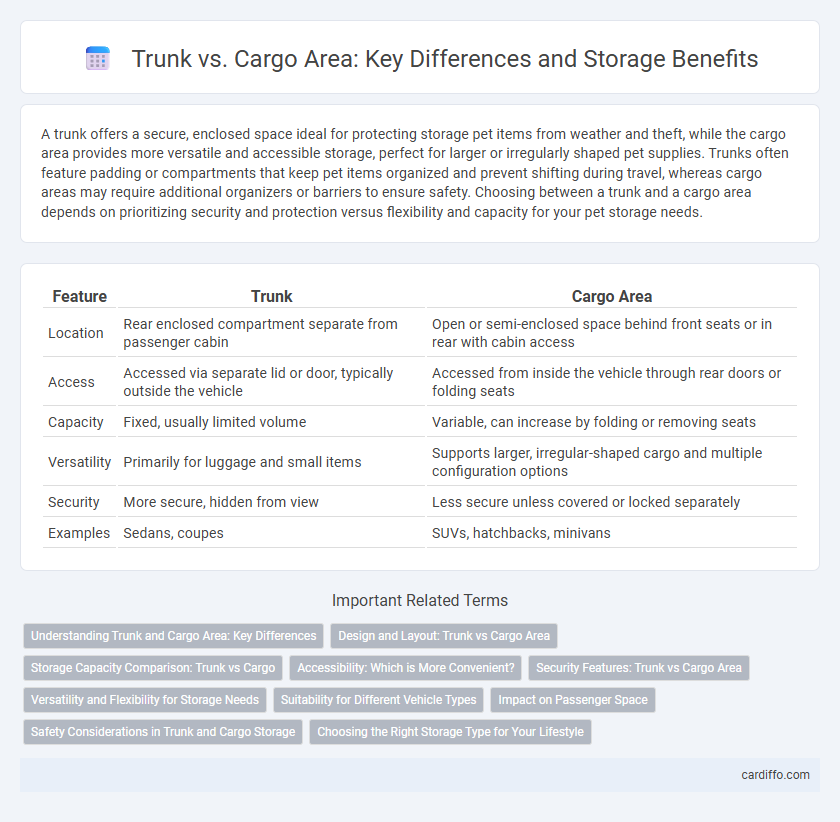A trunk offers a secure, enclosed space ideal for protecting storage pet items from weather and theft, while the cargo area provides more versatile and accessible storage, perfect for larger or irregularly shaped pet supplies. Trunks often feature padding or compartments that keep pet items organized and prevent shifting during travel, whereas cargo areas may require additional organizers or barriers to ensure safety. Choosing between a trunk and a cargo area depends on prioritizing security and protection versus flexibility and capacity for your pet storage needs.
Table of Comparison
| Feature | Trunk | Cargo Area |
|---|---|---|
| Location | Rear enclosed compartment separate from passenger cabin | Open or semi-enclosed space behind front seats or in rear with cabin access |
| Access | Accessed via separate lid or door, typically outside the vehicle | Accessed from inside the vehicle through rear doors or folding seats |
| Capacity | Fixed, usually limited volume | Variable, can increase by folding or removing seats |
| Versatility | Primarily for luggage and small items | Supports larger, irregular-shaped cargo and multiple configuration options |
| Security | More secure, hidden from view | Less secure unless covered or locked separately |
| Examples | Sedans, coupes | SUVs, hatchbacks, minivans |
Understanding Trunk and Cargo Area: Key Differences
The trunk is a dedicated, enclosed storage space located at the rear of a vehicle, primarily designed for luggage and secure storage. The cargo area, often found in hatchbacks, SUVs, and trucks, offers a larger, more versatile space that can be accessed from the rear seats and customized for transporting bulkier items. Key differences include accessibility, size, and configuration, with trunks providing a separate compartment and cargo areas allowing for flexible use and greater volume capacity.
Design and Layout: Trunk vs Cargo Area
The design and layout of trunks typically prioritize enclosed space optimized for passenger vehicles, featuring a fixed, compartmentalized structure that secures luggage. Cargo areas, especially in SUVs and hatchbacks, offer more flexible layouts with foldable seats and open access, enhancing versatility for larger or irregularly shaped items. This adaptability in cargo areas often includes configurable floor heights and tie-down points, maximizing storage efficiency compared to the more rigid trunk designs.
Storage Capacity Comparison: Trunk vs Cargo
The cargo area typically offers greater storage capacity than the trunk, especially in SUVs and hatchbacks where the rear seats can be folded down to increase space. Trunks in sedans provide a more enclosed and secure storage option but have limited volume compared to the versatile and expansive cargo area. Measuring cargo space in cubic feet highlights significant differences, with cargo areas often exceeding trunk capacity by 20-50% depending on vehicle design.
Accessibility: Which is More Convenient?
Trunk accessibility typically involves a fixed opening with a liftgate or trunk lid, limiting entry to a single rear-facing access point. Cargo areas, especially in hatchbacks and SUVs, offer wider openings and foldable rear seats that enhance loading flexibility and ease of access. For frequent storage needs or bulky items, cargo areas provide more convenient and versatile access compared to traditional trunks.
Security Features: Trunk vs Cargo Area
The trunk typically offers enhanced security features such as a solid, lockable compartment that is separate from the passenger cabin, reducing the risk of theft or unauthorized access. Cargo areas, especially in SUVs or hatchbacks, may provide less protection due to their open design and direct access from the rear seats, potentially exposing valuables. Advanced vehicles often include sensor-activated locks or alarms integrated into the trunk but may lack these comprehensive security measures in the cargo area.
Versatility and Flexibility for Storage Needs
Trunk storage typically offers a secure, enclosed space ideal for everyday items and groceries, maintaining organization with limited configurability. Cargo areas provide greater versatility by accommodating larger, irregularly shaped items through fold-flat seats and customizable compartments. Flexible storage solutions in cargo areas enhance utility for diverse needs, making them preferred for active lifestyles and transporting bulky gear.
Suitability for Different Vehicle Types
The trunk is typically designed for sedans and compact cars, offering a secure, enclosed space ideal for smaller loads and valuables. In contrast, the cargo area is common in SUVs, hatchbacks, and trucks, providing more versatile and accessible storage for larger or bulkier items. Each storage type caters to the specific vehicle's design, maximizing usability and convenience based on size and intended usage.
Impact on Passenger Space
The trunk typically offers a separate enclosed storage space that does not impinge on the passenger cabin, preserving legroom and seating comfort. In contrast, the cargo area, especially in hatchbacks or SUVs, shares space with the passenger compartment, which can reduce rear passenger space when fully loaded. Choosing between trunk and cargo area storage directly influences vehicle interior spaciousness and passenger comfort.
Safety Considerations in Trunk and Cargo Storage
Trunk and cargo area storage both require attention to safety, especially in securing items to prevent shifting during transit, which can cause distractions or accidents. Heavy or large objects stored improperly in the trunk may affect vehicle balance and handling, increasing rollover risk. Using cargo nets, straps, or barriers can enhance safety by keeping stored items stable and reducing potential hazards in both storage spaces.
Choosing the Right Storage Type for Your Lifestyle
Choosing between a trunk and a cargo area depends on your lifestyle needs and storage preferences. Trunks offer secure, enclosed storage ideal for protecting valuables and keeping belongings out of sight, while cargo areas provide flexible, open space perfect for transporting larger items or accommodating outdoor gear. Prioritize trunk storage for everyday commuting and city driving, but opt for cargo area space if you frequently carry bulky equipment or require versatility in organizing your load.
Trunk vs Cargo Area Infographic

 cardiffo.com
cardiffo.com